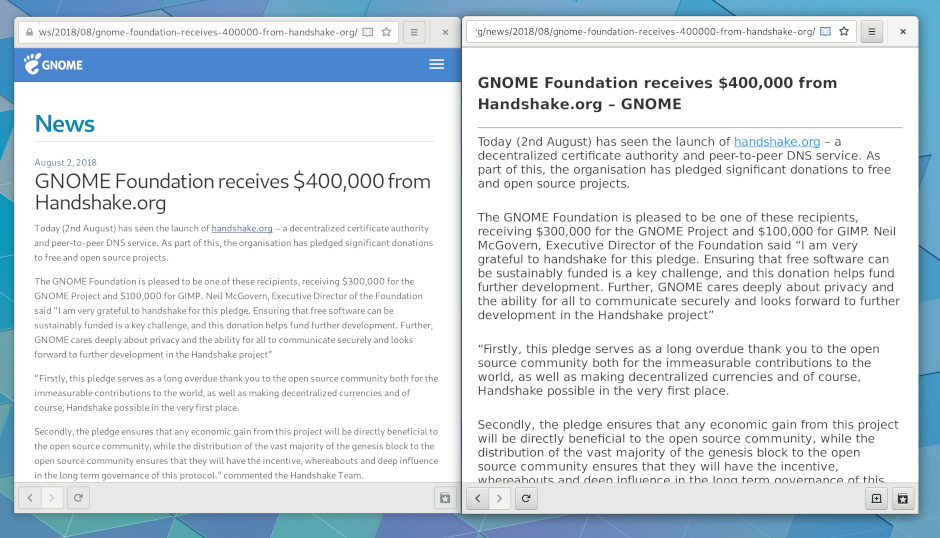Today, the GNOME project announced the release of GNOME 3.30.
The release of the GNOME desktop is the default desktop environment in the upcoming release of Fedora 29 Workstation. GNOME 3.30 includes a wide range of enhancements, including:
- Better performance in the overall desktop and system libraries
- Numerous improvements to the Files, Web, and Boxes applications
- A new Podcasts application to help manage and listen to podcasts

The new Podcasts application in GNOME 3.30
Application updates in GNOME 3.30
GNOME 3.30 includes some updates to many standard applications. Files has a combined search and file path bar interface, making searching more prominent and integrated into the navigation experience. Boxes can now connect to Windows Servers over RDP, resulting in a much better remote desktop experience.

Comparison of normal web view and reader mode
Web now includes a content reader mode. When viewing a compatible web page, Web can toggle between the normal view and the clean, minimal reader view. The minimal view strips out all extraneous menus, images, and content not related to the article or document, making for a more pleasant reading experience.
Read more about this release
There are many more changes and enhancements in this major version of GNOME. Check out the release announcement and the release notes from the GNOME Project for more information.
Screenshots in this post are from the GNOME 3.30 release notes and screenshot pack.






Leslie Satenstein
Around 2005 or thereabouts, I started with Fedora core and Gnome. Twice a year or thereabouts I looked forward to a new release of both Gnome and Fedora, and enjoyed both delivering new features and benefits.
I look forward to testing and migrating to the Gnome 3.0 ASAP.
And then the competition begins, between previous version of Gnome and the new version. Guess which one will win?
Lukas
The new one wins. If you want stability, choose something like *box.
Would prefer to remain anonymous
The one after the current release of course! I can’t wait for 3.32 myself. Fedora 30 can’t come soon enough!
I’m tempted to try the Fedora 29 on a separate partition to see what GNOME 3.30 is like. Does anyone know if it’s in there yet?
Frederik
I can’t wait for GNOME 4.20 and Fedora 42.
Hans Meiser
Use a virtual machine instead
Hans Meiser
Yes, of course F29 carries Gnome 3, already now. We are days away from the beta release. See https://apps.fedoraproject.org/packages/gnome-shell
svsv sarma
Fedora and Gnome make a good combination. I accidentally come across with Fedora last year and stuck with it. So far it never failed me in any respect. It has solid foundation and build. It retains its functionality even though updates are regressive sometimes but manageable with Timeshift. looking forward to the next version.
Javier Guala
Creo firmemente que Fedora es la única distribución que hace ver a Gnome extremadamente elegante. Y por esa razón elijo Fedora.
[TRANSLATION NOTE: I strongly believe that Fedora is the only distribution that makes Gnome look extremely elegant. And that’s the reason why I choose Fedora. — Ed.]
Jesse
This is all meaningless to us with HiDPI displays.
We want to see better scaling come out of the distro. Right now we are stuck with either 200% or 100%. Neither works well.
If I scale down to 1900×1080, not only am I not able to make full use of my 4k screen, but some apps do not scale down correctly.
Firefox’s minime/maximize/close(X) buttons for example, remain abnormally huge. Sure this may be a firefox issue but I think in reality it is a Fedora issue.
In KDE, fractional scaling is available. Firefox looks beautiful there. All GTK apps work great, but try running a QT app in Gnome and that same is not true.
KDE is pulling ahead, way ahead, in terms of design and UX. Gnome has a lot of potential, especially now that most of the big distros are behind it. I hope it is not wasted.
KDE is looking and working better in many ways but they still lack some of the integration with Google Email that I need. The integration of GNU software to Seahorse(password manager) also keeps me from being able to use KDE. (evolution mail client for example, expects to use gnome keyrings instead of KDE wallets).
Alfie
Jesse, Fedora should use Wayland by default. GNOME on Waylands should allow you to use fractional scaling. You should see intermediate options like 125%, or 150%.
If you’re using X.org (e.g. because of NVIDIA drivers), have a look at https://github.com/burntcustard/x11-fractional-display-scaling
Jesse
What is the command to check if I am using Wayland?
As far as I am aware, I am using Gnome on Wayland however, I do not see those options(fractional scaling). I know there is a way to add it by running a command line, but this is 2018, that option should be available outside the command interface.
I also do not want to add it through the cli because it is mentioned as a beta test, not a stable fix.
I do not have Nvidia drivers.. I just use the integrated video (intel.. this is a lenovo yoga pro 2 ultrabook).
Version 3.28.2 << my Gnome version
Link Dupont
I check the value of the XDG_SESSION_TYPE environment variable. If it’s set to “wayland”, then you know you’re running a wayland session. If you’re running Fedora 28, and you have an Intel GPU, there’s a very good chance you’re using a wayland session.
I’d love to hear other methods people use to detect a wayland session.
Jesse
Okay, so I confirmed I am using Wayland. Thanks Link Dupont!
[jv@LenovoPro2 ~]$ echo $XDG_SESSION_TYPE
wayland
[jv@LenovoPro2 ~]$
However, this brings up the concern that I am using Wayland, Fed 28, and I do not have the fractional scaling options that Alfie mentioned I should have. Is there something I am missing?
Gnome is great by the way! I appreciate all the work that Gnome developers have put into it. However, my original comment was regarding the UX of Gnome. The minimalist approach is great and efficient but don’t leave out the power users either. I would like the abilities that KDE provides out of the box. Dolphin is great for example. However, try running a QT app on Gnome and you will see how crappy it looks. KDE on the other hand renders the GTK apps nicely. The only thing that keeps me on Gnome after Experiencing(it is an experience), is the requirement of Evolution email client’s integration to gnome-keyrings.
Gnome is great though, but compared to KDE it requires a lot of extensions to do things KDE can do without a bunch of add-ons. The only reason why this is a problem is because each add-on, extension, provides a new opportunity for making the DE unstable and increasing memory/resource foot print.
Plus visually, KDE, is consistent and standarized.. makes it look more professional.
Looks like Gnome 3.3 will finally incorporate some of the nicer fonts. I will wait to see it.. October is too far away!.. Tempted to use Rawhide lol.. Like I did when I couldn’t wait for Fedora 24.
Flo
echo $XDG_SESSION_TYPE is a good one. I do the following:
loginctl
then
loginctl show-session -p Type
or simply loginctl show-session
Flo
de facto, Fedora is using Wayland as default. The only use case in which you end up with Xorg as default is when you have an nvidia card that is not supported by open-source drivers.
Steve
I was a user of KDE for many years when Mandrake was the name of the distro, and later Mandriva. I switched to Gnome originally due to improvements in it during the Gnome 2 initial release, which saw it outperforming KDE in some respects. Currently, I believe what holds back KDE is it’s lack of Wayland integration.
Ed0c
Hi !
In order to harmonize things between gtk and qt look , check this :
https://wiki.archlinux.org/index.php/qt#GTK.2B_and_Qt
Remember to set your environment variable in etc/environment: QT_QPA_PLATFORMTHEME=qt5ct
Install qt5ct, and voila.
For Hidpi screens, read this part :
https://wiki.archlinux.org/index.php/HiDPI#Fractional_Scaling
In my case, I chose not to do this, because in some applications, like firefox for exemple, things seems blurry. So I prefered to change the scale of the font with Gnome Tweak Tool to 1.25. In firefox, you can do the trick in the page about:config , you can modify the variable layout.css.devPixelsPerPx to whatever you want. I chose 1.25, and things look good and usable.
Hoping to help
Jesse
Hi Edoc,
Yes, that is the CLI command I mentioned. However that seems like it is only a hack.
I was hoping we can get a fully supported solution.
Thans for the information.
wertz
yes, gnome 3.30 and fedora 29 is here… cant wait for gnome’s next release and fedora 30.
Link Dupont
To be clear, GNOME 3.30 is released, but Fedora 29 is not (yet). This is a preview of what will be coming in Fedora 29.
Bill Chatfield
Is it still going to hog all the memory on my 2 GB machine?
Paul W. Frields
@Bill: Why are you trying to run a modern desktop OS on a 2GB machine? Sounds like you want something designed for older hardware, or at least a slim DE.
Roberto
Paul, some people (like me) lives in poor country with horrible employees, have a computer with 2 GB is (really believe me) a luxury tech gadget. I’m mexican and can tell you that I’m very lucky to have a computer with fedora LXQt, because my favorite OpenSUSE (with GNOME and KDE) don’t run anymore in my basic hardware. I wish forever Fedora have light alternatives, if not many people we have to look another options.
Link Dupont
While Fedora Workstation ships GNOME as the default desktop, nothing is stopping you from installing any other desktop environment you want on an existing Fedora installation. Alternatively, you can see if one of the Fedora spins provides you with a lighter desktop. Maybe the LXQT spin?
Kaiser
Roberto is already using LXQt on Fedora. He is praising Fedora because of this. He is actually wishing Fedora continues offering these options in the future. I think you intended to reply to Paul or Bill?
Link Dupont
Ah, I misread his comment the first time. I took it to mean he was suggesting the commenter try LXQT. But you’re right! I reread it and he definitely does like it. Thanks for pointing that out.
Paul W. Frields
@Roberto: Of course, and that’s why these alternatives make great choices for low-RAM machines. My objection is to believing or assuming all desktop environments should be used on low-RAM machines. Everyone should choose wisely for their situation; every alternative isn’t intended to fit their case.
Jack
It’s so annoying when something gets released and there isn’t even a way to try it!
Come on at least provide some ISO with the new version when you announce it…
Link Dupont
There’s two ways you can try parts of GNOME 3.30 today. First, if you understand the risks of running pre-release software, you can try Fedora rawhide. As of this comment, it has a lot of GNOME 3.30 already. Alternatively, you can run some of the apps through Flathub; the GNOME applications will slowly trickle up to 3.30 versions in the next few days.
no name
you don’t need rawhide, you can already run fc30 like I do (it’s unreleased but repos work)
Link Dupont
Fedora 30 has not branched from rawhide yet. If you want to run what will eventually become Fedora 30, you need to use the rawhide repositories. Perhaps you meant Fedora 29? If that is the case, then yes, Fedora 29 has branched from rawhide and you can upgrade a current Fedora 28 system to Fedora 29. All the usual caveats about pre-released Fedora releases still apply.
svsv sarma
Yes, every one wants to be up to date. Mine is 2015 HP Notebook with i3 2.4GHZ/4GB and hope it holds good for FEDORA for another decade!
Jesse
I just read that Gnome allows for Client Side decorations and that this is part of the why many gnome apps look different from each other.
If this is the case, can we stop CSD? I think if we would want to have a consistent feel and look to the windows. We should not allow CDS. If you want to allow CSD so that people can move the close button, why not just offer that as a configuration setting?
Anyways.. if CSD is what is causing apps to look different, especially in HiDPI displays, then we should stop that. It allows all the apps look inconsistent.
Just read the comments on this page:
https://blogs.gnome.org/mclasen/2013/12/05/client-side-decorations-in-themes/
This is probably one of the reasons why KDE looks so much cleaner and professional.
thanks,
Flo
You’re kidding, right? The blog you’re referring to is 5 years old. Also, you don’t have to mess around with CSD. Just leave everything in its default settings and you will get the cleanest and most professional looking desktop ever.
Jesse
Can Gnome be ported to use QT instead of GTK?
Or does it depend on whatever Wayland uses? I am still new to understanding the whole stack and what roles QT/GTK play with Wayland/X11, vs Gnome/LXQT/KDE…
thanks
Flo
Check out this: https://www.reddit.com/r/linux/comments/3r8nev/eli5_history_of_gtk_qt_x11_and_wayland/
GTK uses GObject
QT uses C++
Aleksandr
Wish Gnome devs will add transparent(with blur) background in GDM login screen some day. The hacking way of doing it is annoying, if you change wallpaper time to time.
Bear
Gnome used to be great up to around the version used with Fedora 24. Best performing was definitely Fedora 21. Since then it is becoming a resource eating hog. I don’t believe that if you do a fresh install and log in, the system should be using 1.2GB or more withouth any programs launched. That is with Fedora 28 and mostly due to Gnome’s requirements (as it is the same situation on other distros). As they keep on removing features in the desktop and built-in apps, it seems counter intuitive that the resource usage keeps on growing as it is. KDE on the other hand keeps on adding features and yet resource usage is actually coming down and feels much snappier on the same machine/configuration.
As a loyal previous Fedora/Gnome user i have since switched to Fedora/KDE and Arch/KDE and it has given all my machines new lives. Every new version coming I try out to see if things are possibly improving, but so far it just feels like it is getting worse. Wayland is coming along nicely for physical hardware, but sadly in Virtual Machines mostly wreaks havoc, so if you are using your favorite ore testing distros in VM’s, you should stick to X.org/Classic
Sergio Durán
I am using the beta and no sign of GNOME podcasts so far, where it is?
Flo
Sergio, seems it hasn’t been built yet. But you can get it as flatpak if you’re interested: https://wiki.gnome.org/Apps/Podcasts
Jesse
I’ve been reading articles online.
Although most primary distributions have settled on Gnome as their default DE, some are considering moving to a QT toolkit rather than GTK.
It is my understanding that GNOME uses the GTK framework/libraries/toolkit. If so, will Gnome make the conversion to use QT as the supporting toolkit?
From what I read, GTK uses C but then has some GObject library that provides it somewhat of an OOP feel. Why not use C++? In which case, why not use QT as it is based in C++?
Where is Gnome headed? It has support from the major players. Hopefully it does not waste that support.
Link Dupont
You’re asking excellent questions, but please consider the history of the two projects. GNOME and KDE are both over 20 years old. They are incredibly huge, complex projects, consisting of a large number of interconnected codebases. Switching the entire project suite from one graphical toolkit to another is an enormous undertaking. Apple did it basically throwing out their old codebase (Mac OS 9) and launching an entirely new operating system (OS X, formerly NeXTSTEP). For GNOME to drop GTK+ and use Qt instead would require an entire rewrite of the entire suite of projects. As you noticed, GNOME is written in C, using the GLib-provide GObject type system. GObject adds many similar higher-level data structures and language features to C without the need to explicitly use C++. Think of it more like Objective-C being a super-set of C.
As far as “where is GNOME headed”, your best bet is to watch the project’s community. Follow blog posts on http://planet.gnome.org, join the community IRC channels, or otherwise find ways to get involved.